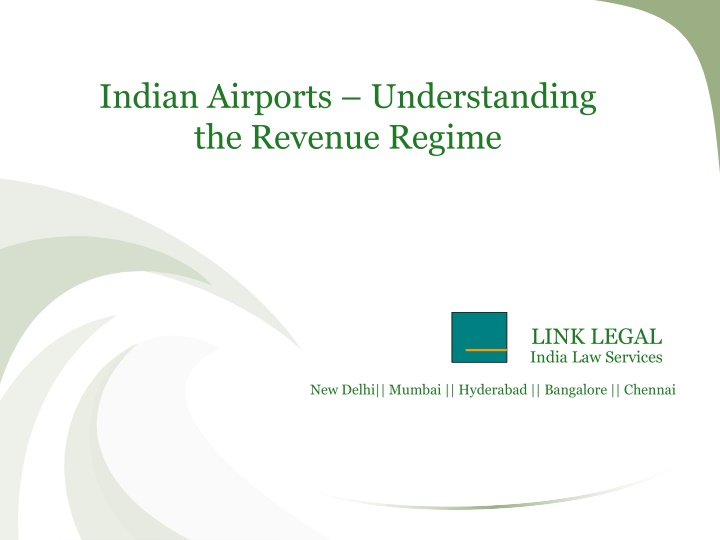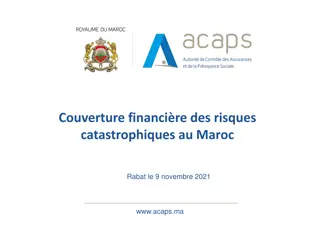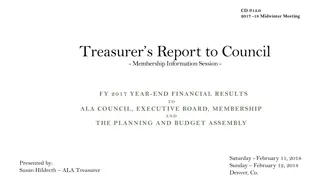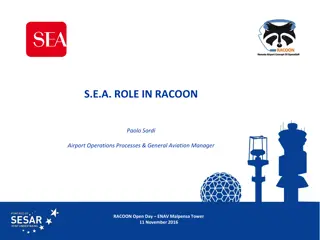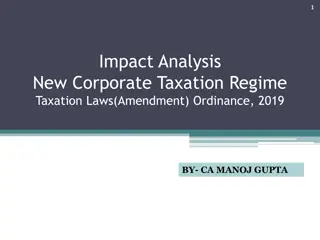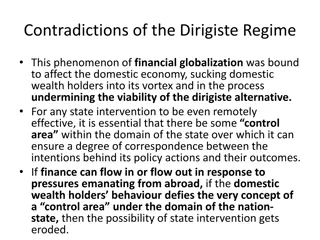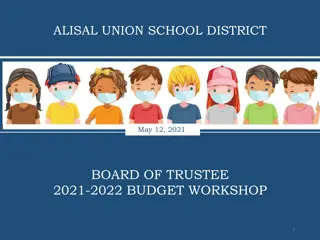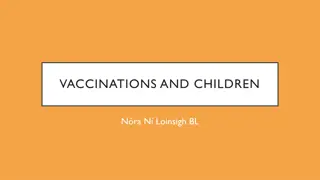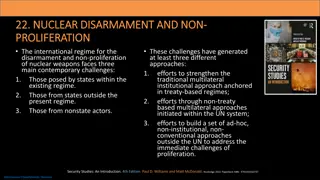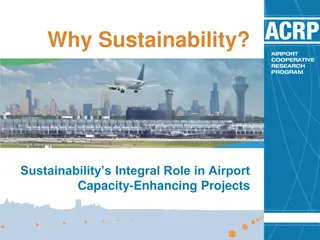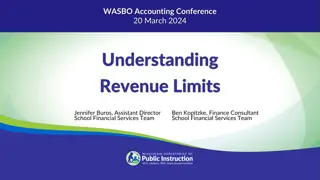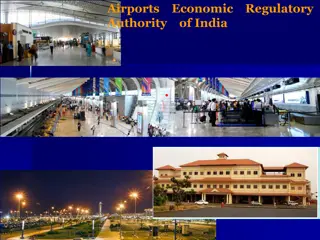Indian Airports Revenue Regime Overview
This content delves into Indian airports' revenue regime, existing infrastructure, growth prospects, regulatory scenario, and economic regulations. It covers key aspects such as regulatory bodies, sectoral policies, proposed legislations, and more.
Uploaded on Feb 26, 2025 | 1 Views
Download Presentation

Please find below an Image/Link to download the presentation.
The content on the website is provided AS IS for your information and personal use only. It may not be sold, licensed, or shared on other websites without obtaining consent from the author.If you encounter any issues during the download, it is possible that the publisher has removed the file from their server.
You are allowed to download the files provided on this website for personal or commercial use, subject to the condition that they are used lawfully. All files are the property of their respective owners.
The content on the website is provided AS IS for your information and personal use only. It may not be sold, licensed, or shared on other websites without obtaining consent from the author.
E N D
Presentation Transcript
Indian Airports Understanding the Revenue Regime LINK LEGAL India Law Services New Delhi|| Mumbai || Hyderabad || Bangalore || Chennai
Existing Airport Infrastructure LINK LEGAL INDIA LAW SERVICES 2
Growth and Future LINK LEGAL INDIA LAW SERVICES 12th five year plan 17 Greenfield and 6 Brownfield airports in the near future. Increase in airports India is 9th largest aviation market globally to become 3rd largest aviation market by 2020 - domestic pax - 209 mn. and international pax - 60 mn. by 2017. Passenger handling - Market size Five international airports completed by PPP model Estimated investment to increase by 66.7 % to USD 9.3 bn. Rising PPP and investment From September 2012, FDI of 49% in air transport services permitted. 100% FDI allowed in airports. Easing of FDI norms Growth upto USD 1.5 bn. estimated by 2020. 100% FDI in MRO. MRO hub 3
Regulatory Scenario LINK LEGAL INDIA LAW SERVICES Regulatory Bodies/Sectoral Policies Directorate General of Civil Aviation - DGCA Airport Infrastructure Policy Key Regulations (with rules issued thereunder) Airports Authority of India Act, 1994 Aircraft Act, 1934 The Airport Economic Regulatory Authority of India Act, 2008 Other applicable legislation including the FEMA, environmental laws, labour, taxation Proposed Legislations - Civil Aviation Authority of India Bill, 2012 4
Regulatory Overview LINK LEGAL INDIA LAW SERVICES MOCA DGCA & BCAS AERA Act, 2008 Aircraft Act, 1934 AAI Act, 1994 Steering Committee (SA) AAI Airports AAI Green Field Policy Airport Co. Airports Site Clearance by SA In-principle approval from SA Brown-field airport - AAI can assign to any third party DGCA license MOCA Ministry of civil aviation AERA - Airports Economic Regulatory Authority DGCA Director General of Civil Aviation AAI Airport Authority of India Proposal referred to MOCA 5
Economic Regulation LINK LEGAL INDIA LAW SERVICES No airport regulatory authority at the time of signing of the concession agreement Section 13 of AERA Act Delhi/Mumbai existing rates were valid for one year from April 2006 and then with revision of 10 percent after the first year and determination by AERA thereafter White paper/consultation paper issued by AERA for all airports pursuant to which tariff orders were passed for Delhi and Mumbai. (order 13 and 14 issued by AERA list out the regulatory philosophy and approach to regulate airport operators) 6
Economic Regulator - AERA LINK LEGAL INDIA LAW SERVICES AERA determines the tariff for aero services taking the following into consideration: Capital expenditure incurred and timely investment in improvement of airport activities; The services provided, its quality and other relevant factors; The cost of improving efficiency; Economic and viable operation of major airports; Revenue received from services other than the aeronautical services; The concession offered by the Central Government in any agreement or MoU or otherwise; and Any other factor which may be relevant. 7
Popular Till Models LINK LEGAL INDIA LAW SERVICES Light touch Single Till Dual till Hybrid Till 8
Single Till LINK LEGAL INDIA LAW SERVICES Light touch Single Till Dual till Hybrid Till 9
Hybrid Till LINK LEGAL INDIA LAW SERVICES Light touch Single Till Dual till Hybrid Till 10
Hybrid Till LINK LEGAL INDIA LAW SERVICES 11
Dual Till LINK LEGAL INDIA LAW SERVICES Light touch Single Till Dual till Hybrid Till 12
Greenfield Airports LINK LEGAL INDIA LAW SERVICES Existing Model Concession granted by the Ministry of Civil Aviation. Exclusivity No new airport development within 150 kms. radius. Right to collect aero and non-aero revenues. Pay revenue share to AAI For GHIAL @ 4% on the gross revenue; For BIAL @ 4% on the gross revenue. Tariff determination by AERA every 5 years or earlier, if required. Single Till approach of tariff determination by AERA: Entire airport is considered to be one unit; Pre-determined rate of return for the concessionaire; and Profits from non-aero activities used to offset the aero cost base for determining airport charges. 13
Brownfield Airports LINK LEGAL INDIA LAW SERVICES Existing Model Lease of Airport to the Concessionaire under Section 12(4) of AAI Act. ROFR for development of new airport within 150 kms. radius. Right to collect aero and non-aero revenues. Pay revenue share to AAI For DIAL @ 46% on the gross revenue; For MIAL @ 38.7% on the gross revenue. Tariff determination by AERA every 5 years or earlier, if required Hybrid Till approach of tariff determination by AERA: Only aero charges are regulated; Non-aero charges are not regulated; and 30% of the non-aero revenues are accounted for subsidising the aero charges . 14
Brownfield Airports LINK LEGAL INDIA LAW SERVICES Proposed Model RFQ Stage License of Airport to the Concessionaire. AAI may provide grant to the Concessionaire by way of equity support in accordance with the bids received. Right to collect aero charges as per prescribed rates. Collect non-aero revenue and revenue from city side real estate. Revenue share payment to commence from the 20th year of the COD, and to increase by 1% every subsequent year. Tariff review by AERA every 5 years or earlier, if required on the basis of the following considerations (without limitation): Traffic growth, RoI and costs incurred in operations; and Adjustments and recoveries under the concession. City side premium 15
Challenges to airports LINK LEGAL INDIA LAW SERVICES Current Experience No single window approval process; multiple stakeholder communities Stringent timelines for development Heavy performance related penalties; service delivery depended on sovereign functions Encroachments across airport land Brownfield development; poor state of existing infrastructure Availability of skilled manpower in airport development and operations Lack of industry status granted; non-availability of lending at preferred rates Conflicts Developers v. AERA Concession Agreement v. AERA Act 16
Thank You LINK LEGAL India Law Services New Delhi|| Mumbai || Hyderabad || Bangalore || Chennai
